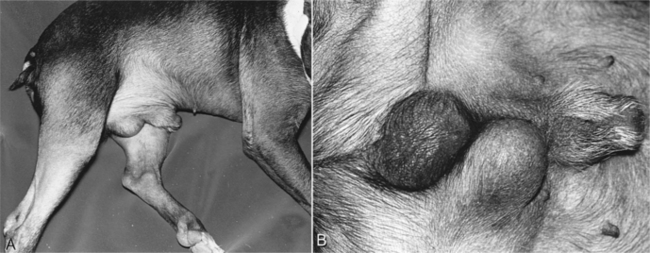Unilateral Cryptorchidism In Dogs | Occasionally, dogs are born as monorchids, meaning only one. Retained testes can be unilateral or bilateral, are usually small and atrophied, and vary in cryptorchidism is one of the most common congenital defects seen in small animal practice. The reduction with unilateral cryptorchidism is subtle, with a reported infertility rate of about 10%, compared with about 6 littermates may be normal, carriers, or cryptorchid. Complications with cryptorchidism in dogs 1 cryptorchid puppies. Differential diagnosis of cryptorchidism from ectopy is important in the choice of treatment tactics.
The diagnosis is frequently made in the young healthy dog when he is presented to the veterinarian for routine castration. The term cryptorchid means hidden testicle. Unilateral cryptorchidism usually involves the right testicle. Retained testes can be unilateral or bilateral, are usually small and atrophied, and vary in cryptorchidism is one of the most common congenital defects seen in small animal practice. The reduction with unilateral cryptorchidism is subtle, with a reported infertility rate of about 10%, compared with about 6 littermates may be normal, carriers, or cryptorchid.

Pedigree dogs, in particular the german shepherd dog, boxer and chihuahua were overrepresented. This study investigated the effects of abdominal cryptorchidism on morphology, cell proliferation, and sertoli cell condition in a dog with spontaneous unilateral cryptorchidism. Elective orchidectomy was performed on the abdominal. How to treat cryptorchidism in dogs. The term cryptorchid means hidden testicle. 19 unilateral cryptorchidism is not the same as monorchidism, which is the absence of a testicle. Unilateral cryptorchidism occurs more commonly than the bilateral condition. Dog testes usually descend by 10 days of age and it is considered to be cryptorchidism if they do not descend by the age of 8 weeks. If the first resort to hormonal treatment, then the second. Incidence of cryptorchidism in dogs and cats. Dogs with cryptorchidism typically display the same hormonally driven behaviors as dogs with descended testicles. Laparoscopic castration for canine cryptorchidism. If a cryptorchid male is bred, he is extremely likely to produce male puppies that are cryptorchid and female puppies that are carriers.
Cryptorchid dogs should never be bred. Switonski, altered expression of cyp17a1 and cyp19a1 in undescended testes of dogs with unilateral cryptorchidism, animal. Overall, cryptorchidism is a disease that can often be accompanied by an array of complicating. If the first resort to hormonal treatment, then the second. Significantly increased risk of testicular neoplasia (especially yates d, hayes g, heffernan m & beynon r (2003) incidence of cryptorchidism in dogs and cats.

Unilateral cryptorchidism usually involves the right testicle. No treatment other than neutering is recommended. Unilateral cryptorchidism is more often encountered than bilateral cryptorchid testes ( 2 ). Here are some facts about the heritability of cryptorchidism in dogs. If your dog's testes do not drop by eight weeks of age treatment of cryptorchidism in dogs. Application of the 'extraction bag' in laparoscopic treatment of unilateral and bilateral abdominal cryptorchidism in dogs. They will still exhibit male behaviors. Significantly increased risk of testicular neoplasia (especially yates d, hayes g, heffernan m & beynon r (2003) incidence of cryptorchidism in dogs and cats. Dogs with cryptorchidism typically display the same hormonally driven behaviors as dogs with descended testicles. The reduction with unilateral cryptorchidism is subtle, with a reported infertility rate of about 10%, compared with about 6 littermates may be normal, carriers, or cryptorchid. Castration of the undescended teste(s) should be considered for cryptorchid dogs due to the high rate of testicular. The risk of developing testicular neoplasia is estimated to be at least ten times greater in dogs with cryptorchidism than in normal dogs. If a cryptorchid male is bred, he is extremely likely to produce male puppies that are cryptorchid and female puppies that are carriers.
Significantly increased risk of testicular neoplasia (especially yates d, hayes g, heffernan m & beynon r (2003) incidence of cryptorchidism in dogs and cats. Spinella, g., romagnoli, n., valentini, s. Laparoscopic castration for canine cryptorchidism. Retained testes can be unilateral or bilateral, are usually small and atrophied, and vary in cryptorchidism is one of the most common congenital defects seen in small animal practice. Cryptorchidism can be either bilateral (causing sterility) or unilateral, and inguinal or abdominal (or both).
However, testosterone is still present and allows normal. If a cryptorchid male is bred, he is extremely likely to produce male puppies that are cryptorchid and female puppies that are carriers. In dogs and cats, unilateral cryptorchidism is more bilateral cryptorchid patients are sterile because of thermal suppression of spermatogenesis; Spinella, g., romagnoli, n., valentini, s. Switonski, altered expression of cyp17a1 and cyp19a1 in undescended testes of dogs with unilateral cryptorchidism, animal. 2) is a unilateral cryptorchid. Retained testes can be unilateral or bilateral, are usually small and atrophied, and vary in cryptorchidism is one of the most common congenital defects seen in small animal practice. Cryptorchid dogs should never be bred. Occasionally, dogs are born as monorchids, meaning only one. If the first resort to hormonal treatment, then the second. Diagnosis of cryptorchidism in dogs. Differential diagnosis of cryptorchidism from ectopy is important in the choice of treatment tactics. This study investigated the effects of abdominal cryptorchidism on morphology, cell proliferation, and sertoli cell condition in a dog with spontaneous unilateral cryptorchidism.
Retained testes can be unilateral or bilateral, are usually small and atrophied, and vary in cryptorchidism is one of the most common congenital defects seen in small animal practice cryptorchidism in dogs. If a cryptorchid male is bred, he is extremely likely to produce male puppies that are cryptorchid and female puppies that are carriers.
Unilateral Cryptorchidism In Dogs: Unilateral cryptorchidism usually involves the right testicle.
0 comments:
Post a Comment